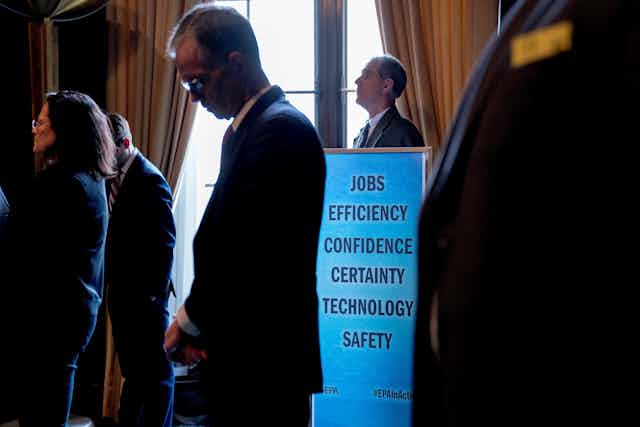It’s official: The Trump administration is reversing steps its predecessor had taken to curb gasoline and diesel consumption through stricter car pollution and fuel economy standards.
Rather than heed growing concerns about climate change, EPA Administrator Scott Pruitt has formally moved to nix the Obama administration’s carefully written rules. In 2012, the EPA set standards that aimed to halve the global warming pollution from new cars and light trucks by 2025. It made those tailpipe limits in coordination with the Department of Transportation’s separate fuel-economy standards, which targeted a near doubling of new vehicle miles-per-gallon over the same time frame.
Embracing auto lobbyists’ rhetoric, Pruitt declared in a press release that the existing policy “didn’t comport with reality, and set the standards too high.”
As a scholar who has researched automotive technology gains in recent decades, I believe this move is not justified by either a lack of technical know-how or the decline in prices at the pump since the government issued its standards six years ago. My own research has long shown that engineering advances offer many ways to ramp up fuel economy and cut tailpipe emissions without making vehicles too costly.
Industry pressure
This backward step was no surprise. The day after Donald Trump’s election victory, auto industry lobbyists dusted off their anti-regulatory scripts and pleaded their case to the incoming White House.
Automakers pressed for weaker standards, arguing that the necessary technologies cost too much, would not be ready on time, and ran counter to consumer trends.
However, I believe that the EPA had more than adequately addressed these concerns in the draft report it issued in July 2016. That analysis built on the earlier technology and economic assessments that justified the landmark standards established four years earlier.
Cheaper gas
One of the Trump administration’s main arguments is that gas costs less now than it did when the government established these standards six years ago. While that affordability clearly benefits consumers, it is no reason to slow down pollution-cutting progress.
Lower fuel prices do trim the immediate economic benefits of stronger standards. But the main rationale for the EPA’s standards is reducing the emissions that cause global warming, and that’s unchanged. Moreover, maintaining stricter standards would protect Americans from very real risks to their wallets if and when oil prices soar again.
Fuel prices nosedived in mid-2014, contrary to industry expectations. After ticking up slowly for the past two years, they remain about US$1.25 lower than when the standards were first conceived.
When it issued the standards in 2012, the EPA estimated that any added upfront vehicle costs would be paid back by fuel savings within three and a half years on average. I estimate that today’s lower fuel prices would push the payback period to about five years. That’s still a good deal given that the average vehicle stays on the road for nearly 12 years.
Lower gasoline prices do make consumers less eager to seek cars and trucks that get more miles per gallon. And it’s quite true that many top-selling models are gas-thirsty trucks like the Ford F-150, Dodge Ram and Chevrolet Silverado.
But the auto industry had the EPA build enough flexibility into the rules to accommodate such shifts in taste. Trucks, for example, are already held to weaker standards than cars, and the standards are automatically relaxed as any given type of vehicle gets larger. For that reason, the regulatory relief that automakers are seeking is not really needed.
What’s more, engineers are forging ahead with an array of technological enhancements designed to make even the largest pickup trucks more fuel-efficient, such as engines that automatically idle at stoplights, auto bodies made from lighter and stronger kinds of steel and other engineering advances.
Striking a balance
The conundrum the EPA faces is a classic one of how to balance consumer concerns about health and safety with their everyday wish to drive appealing vehicles that meet their needs and fit their budget.
The Trump administration seems to believe that automakers’ natural desire to cater to short-term market desires outweigh long-term concerns about the environment. That brings us back to the real reason the country needs strong and steady clean car rules. History shows that regulations work, and the fact that car manufacturers have clearly improved safety and cut emissions even while vehicle sales reached new highs contradicts the industry’s argument that regulations force them to build cars that customers don’t want to buy.
Automotive technology is always advancing, and at any given point in time it can be used to either reduce emissions or offer more horsepower, added capacity, or any number of other amenities such as heated seats. And the list goes on. There’s nothing wrong with these features, but they don’t justify doing less to curtail global warming.
The history of automotive policymaking shows that consumers can in fact have cars that are both nicer and cleaner. The first car I owned – a 1967 Ford Custom 500 with a stick shift that got less than 20 miles per gallon – was quite spartan by today’s standards. It was no match for my family’s current car, a 2012 Toyota Camry hybrid that gets over 35 miles per gallon and is far more powerful, safer and comfortable while still quite affordable.
Without regulations, that Camry would no doubt be at least as nice in terms of creature comforts, but it would not be as safe, efficient and clean. That is why I’m certain that carefully crafted regulations do strike the right balance, in spite of automakers’ complaints to the contrary.
In short, the Trump administration’s main justification for weakening the standards – less-than-expected consumer interest in efficiency due to lower gas prices – is actually the reason why the nation needs more stringent standards in the first place.

